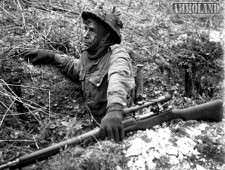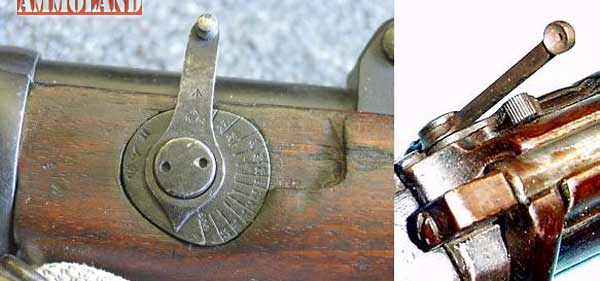By Marc Cammack


Bangor, Maine – -(Ammoland.com)- The Lee Enfield rifle MKIII is widely known as the rifle of the British Army during the First World War and beyond. Another rifle made in the United States would serve in the British Army during both World Wars, and that rifle was the Pattern 14.
The Pattern 14 would also serve as the basis for the American M1917 Enfield rifle .30-06, which Alvin York would use to win the Medal of Honor.
The Pattern 14’s origins lay in British experimentation with Mauser type actions, and a need for more rifles to fight the Germans in the First World War. During the Second Boer War, British soldiers would fight against Boers armed with 7mm Mauser rifles, and find themselves outgunned. A .276 caliber round would be developed starting in 1908, and in 1913 a prototype rifle had been built. This prototype rifle was called the Pattern 1913, and made at the Royal Small Arms Factory at Enfield.
Before issues in the rifle could be worked out, the First World War broke out in Europe.

The British military would find itself lacking rifles for their rapidly expanding number of soldiers. There were not enough of the standard Lee Enfield rifles in service at the time. The Pattern 1913 would be modified into the much more common .303 round to meet the demands of the war effort. This new rifle was much easier to produce than the Lee Enfield, and three American companies would be tasked with manufacturing the rifle.
The companies were Remington, Winchester, and Eddystone. The majority of the Pattern 14 rifles would be made in the year 1916. Total production would be about 1.2 million units. The receiver on Eddystone rifles are marked “ERA”. Remington rifles are marked “RE”, and Winchester rifles are marked “WRA” on the receiver.
While the standard Lee Enfield rifle featured a 10 shot detachable magazine, the Pattern 14 only held 5 rounds in an integral box magazine. The Pattern 14 rifle also featured a new model blade bayonet called the Pattern 1913. These bayonets were made by the same three manufacturers as the rifle. A nearly identical version of this bayonet called the M1917 would be used on the American M1917 Enfield and Winchester 1897 Trench shotgun.

The Pattern 14 like many early Lee Enfields featured a volley sight on the left side of the stock. This second set of sights was intended to be used for area fire at ranges of 1500 yards or more. The sight is adjustable from 1500 to 2600 yards. Many Pattern 14’s were rebuilt and had the volley sights removed. A Pattern 14 with intact volley sights brings more than one without.
A sniper variant of the Pattern 14 was used late in the First World War. Only Winchester made rifles were selected for sniper rifles due to Winchester’s reputation for building a more accurate rifle. The Pattern 14 was picked over the standard MKIII Enfield due to its accuracy, and existing rifles were converted to sniper configuration in England by adding a 3 power Model 1918 scope.

The Pattern 14 had an interesting and limited combat history in the First World War. By the time Pattern 14s began arriving in Britain, Lee Enfield production were being produced in sufficient quantities to arm the Commonwealth forces in Europe. Many were used in reserve units and to train new recruits. The Winchester sniper rifles were used starting in 1917 due to their superior accuracy over the Lee Enfield MKIII.
Following the First World War surplus many Pattern 14’s would be sold off. The Latvian army used many Pattern 14s and many of the rifles would be used by Republican Forces in the Spanish Civil War. During the Second World War Two Pattern 14 rifles were issued to the British home guard in case of Nazi Invasion. The Winchester Pattern 14 sniper rifles would also see use during the Second World War.

About Marc Cammack
Marc Cammack has been collecting firearms since he was 14 years old.
His interests are primarily military surplus firearms of the late 19th into the 1950’s. He has studied these in depth, and currently volunteers at two local museums providing them with accurate information about their firearms.
He is a graduate of the University of Maine with a bachelor’s degree in history. He has studied modern European and American history since the age of 9, and has been shooting since the age of 11. He currently resides just outside of Bangor, Maine.

I have the receiver for a P14 marked RE ( Remington) but it does not fit the P14 stock that I have which is stamped DP ( Drill Purpose, The receiver number is 35524. How can I track its calibre 303..or 3006 and a fit for a stock.
this may be an unrefined method, but try to drop a .303 cartridge into the chamber. If it fits, then it definitely won’t fit the slimmer, straight-walled 30.06 cartridge.
I have a pattern 14 ERA rifle,i have heard different cal for this,303/30-06..A little confused,on the stock(bolt side) IE in a circle,Patt’14,EY below the Patt’14,(i understand that the EY was an emergency designation) above the bolt carrier is ERA 8517,is this the yr manufactured ?? EY is also stamped with some Brit markings on the reverse side..The rifle has the original Volley sight(front and back)…Any help would be appreciated,thanks..
I own 4 p14’s.,
That I load my own ammo for.
You will find the p14 very reliable. They were built of the finest steel.
I have changed the bullet from 180 gr. down to a 150 gr .inter lock., Speers
Load with H-335 / 42g..Roughly 2700 fps.
All 4 guns handle this very good ,
At 100 yds., not bad at all..
Robert S.
I have a P14 But 303 shells won’t fit or 3006 /308
Probably a 276 caliber
If so, that just made the rifle a lot more rare and valuable. The typical dead giveaway for the pattern 13 was the four diagonal finger grooves over the long horizontal groove on the side of the rifle.
I have bought a p14 303 with the s # w109989. but can’t seem to find the year it was manufactured . Wonder if you could help me ?
Rob.
The year of manufacture should be stamped on the left side of the barrel shank. You will need to remove the hand guards. The date will be abbreviated to read ’16 for 1916 etc.
Hi
I have a P14 Converted to a sport rifle. It Constantly jams any rounds placed in the Magazine. What am I missing.?
FMJ’s? Bad or incorrect Magazine plate.??
Can this Rifle be modified to take a removable clip.
Thanks
Ken
just bought one. Where can I obtain parts?
Numrich Arms
I have what I think is a p14, .303 just bought at a a gun show very good condition has ERA on the receiver, integral mag, and it’s got a gold us coin inbed in as the stock disc so surely a mod. payed $150 for it, if it is stamped ERA then it would be the millions produced by Remington, Wichester or Eddystone right, so should place the rifle to 1914 or were there production of this rifle in the following years
i have shot modern ammo out of my pattern 14 with no issues other than federal ammo makes it dirty fast
I have one, but have only shot surplus ammo out of it. Can you shoot modern ammo out of these without fear of failure
I load modern ammo for my p14 . Handles very good . At 100 yds. The group is really very tight for a 103 year old gun.
To answer you Question .on modern ammo , yes, The steel in a p14 is a better quality then most modern guns of today.
Hope this puts your mind at ease .Rob